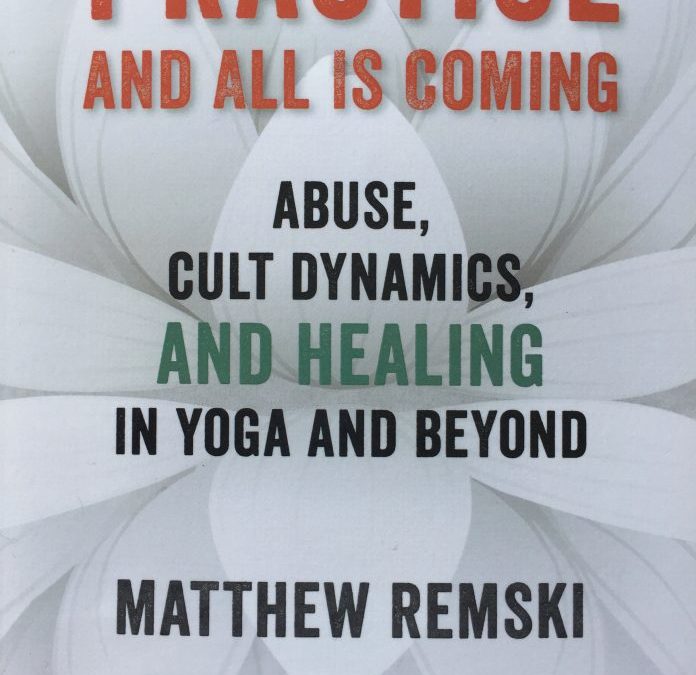I’m a lifelong Ashtanga practitioner. Well strictly speaking I’m practising for around 30 years but I consider it lifelong because I think if there was something that would have made me stop I would have likely found it by now. As a lifelong Ashtanga practitioner I can’t hide that I found Remski’s book a difficult read. I knew most of the things he wrote about but it’s different to read over 300 pages a systematic presentation of everything that’s wrong with the system you love. Although coming out of reading the book with a long face I nevertheless think it’s the moral duty of every Ashtanga teacher to read it so we can start the work on renewing our culture. I also think that all those who are not teachers but have made this their main practice should read this book so that they can engage their teachers in a dialogue about what needs to change.
Apart from the obvious things what I got out of the book was
- An understanding how group psychology enabled Jois’ abuses and silenced his victims. His actions could have never taken place without a whole culture supporting and enabling him. This culture is still in place and exaggerates the role of teachers and downplays the importance of sensations felt by students when they are adjusted.
- An understanding how loaded language hypnotized followers into the belief that what Jois did was right. Remski skilfully analyses language presented in Guruji- A Portrait Through the Eyes of his Students to show how senior teachers through their use of language effectively pre-groomed students and forwarded them to the abuser.
- A better systematic understanding of the weird Ashtanga-belief that simply doing your asana practice would lead to yoga’s goal. I have extensively written about that before and shown that this belief is not consistent with yogic philosophy (in which asana is only used to prepare for sitting higher-limbs practice). Remski has improved my understanding of how these weird Ashtanga-beliefs lead to over-practising and via that to many injuries.
- An introduction to the writings of various psychologists on high-demand groups (cults) and the mechanics of hierarchy.
- The workbook at the conclusion of Remski’s book offers tools to examine and questions ones own beliefs (both for practitioners and teachers) and contains suggestions for safe practice and how we can avoid aggrandising teachers which leads to trouble for both them and their students
What I did not find in the book was sensationalism and enmity towards Ashtanga. Remski honestly states at the outset that he is a double cult-survivor and was himself injured in an adjustment. He therefore questions his own impartiality and alerts himself to possible perceptual biases and commits himself to overcome them.
Ultimately it is a book that Remski has written as part of his own healing. We can use his work to heal our culture and make our magnificent Ashtanga-method here to stay.
But first we need to face the truth. And that is not only the truth of what happened but also the truth of how this was possible. And most of those in power in our culture keep denying or at least say Jois is dead and therefore the problem is gone. It is this very attitude that prevents the implementation of vital and urgently necessary changes. This is our chance now! Read the book! Start the dialogue with those around you and become the change.


I haven’t read his book but I don’t see how the things you mention here are outside of what you have presented in books, blog posts and in person. How was this painful for you? I think you’ve done an excellent job in stating your views on Ashtanga and spiritual teachings and practices.
Again I haven’t read the book, but I would probably lead Ashtanga teachers in the direction of your writings rather than Mr Remski’s. His previous writings has been through the lens of a worldview I find hard to sympathise with.
All the best,
Hello Emil,
I haven’t read Matthew’s previous writings to can’t really comment on it. I thought it was easier to reject my opinion on KPJ’s abuse than Matthew’s writing since, although I witnessed the abuse myself it wasn’t corroborated by 18 victims testimonies and 100reds of pages of other supporting evidence.
Yes, I suppose it was painful to have to leave the community back then in 1999. Bit like loosing ones spiritual home. I left spiritual communities on several occasions and I think by then I had become quite battle-hardened in that matter. Probably in the long-term the outcome was good as it forced me to rely not on so-called authorities but on my own research and practices.
I’m still surprised that after all the abuse is now openly discussed by many, a big part of the Ashtanga-mainstream still prefers to ignore the issue rather than addressing it.
Hope this finds you well
Gregor